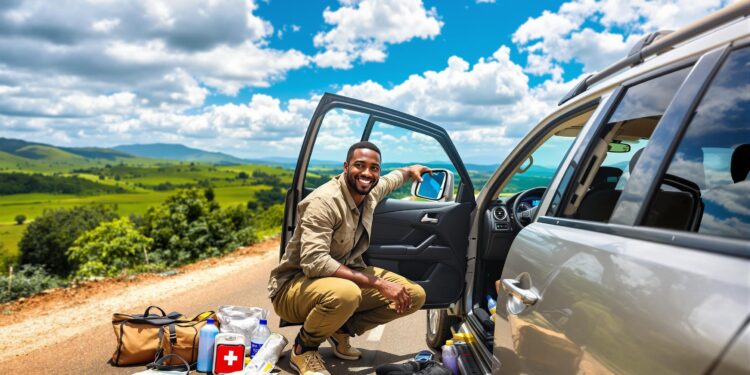Driving long distances in Uganda can be challenging due to varying road conditions, weather, and traffic rules. Here’s a quick overview of the 10 key safety tips to ensure a smooth and secure journey:
- Inspect Your Vehicle: Check engine fluids, brakes, tires, lights, and safety equipment like a first aid kit and reflective triangles before your trip.
- Maintain Tire Pressure: Ensure proper tire inflation to avoid blowouts and improve fuel efficiency.
- Plan Your Route: Use reliable tools like Google Maps or Waze and check road conditions, especially during the rainy season.
- Pack an Emergency Kit: Include medical supplies, tools, water, snacks, and survival gear suited for Uganda’s regions.
- Take Breaks: Rest every 2-3 hours to avoid fatigue and stay alert.
- Know Traffic Rules: Follow speed limits, drive on the left side, and avoid distractions or alcohol.
- Adapt to Weather: Slow down in rain or fog, use low beams, and maintain extra distance from other vehicles.
- Secure Your Belongings: Lock your car, hide valuables, and park in secure, well-lit areas.
- Use Navigation Apps: Download offline maps and plan routes in advance to avoid getting lost.
- Stay Connected: Share your itinerary, carry a local SIM card, and check in regularly with contacts.
Tips for Driving in Uganda
1. Check Your Vehicle Thoroughly
Before hitting the road for a long trip in Uganda, it’s crucial to inspect your vehicle carefully. Uganda’s roads can range from smooth highways to rugged rural paths, so preparation is key.
"A thorough vehicle inspection ensures peace of mind before a long trip", says Mike Katamba, a garage owner in Ndebba.
Here’s what to focus on:
Engine and Essential Systems
- Make sure engine oil, brake fluid, power steering fluid, and coolant levels are all topped up.
- Test all lights, including headlights, brake lights, and indicators.
- Confirm that your windshield wipers are working properly.
"Ignoring a dead water pump risks overheating and serious engine damage", warns Robert Kawooya, a mechanic in Ntinda.
Brakes and Tires
- Check that the brake system is functioning properly.
- Inspect your tires for correct inflation, even wear, and any visible damage.
- Don’t forget to check your spare tire – make sure it’s in good condition and accessible.
- Confirm that your jack and other necessary tools are in working order.
Safety Equipment
- Pack a basic toolkit.
- Bring a flashlight with extra batteries.
- Ensure you have a fully stocked first aid kit.
- Include reflective triangles for emergencies.
Plan this inspection at least a week before your trip to allow time for any needed repairs. If you’re not comfortable with vehicle maintenance, take your car to a certified mechanic. AutoMag.ug recommends this step to address the unique challenges of Uganda’s roads [2].
Once your car is ready, double-check your tire pressure – it’s a simple but critical step for a smooth and safe journey.
2. Maintain Correct Tire Pressure
Keeping your tires at the right pressure is crucial for safe driving, especially in Uganda, where road conditions can vary widely. The American Automobile Association (AAA) notes that underinflated tires can lower fuel efficiency by up to 3% and increase the risk of a blowout by 25% [2].
How to Find the Right Pressure
You can locate the recommended tire pressure on the driver’s side doorjamb, fuel filler door, tire sidewall, or in the owner’s manual.
Tips for Monitoring Tire Pressure
David Mugisha, a tire expert from Kampala Tire Center, offers this advice:
"Check your tire pressure weekly and always before long trips. In Uganda’s varying temperatures and road conditions, tire pressure can fluctuate significantly."
How Weather Affects Tire Pressure
Uganda’s weather can impact tire pressure. Hot weather tends to increase it, while colder or rainy conditions can cause it to drop. To stay safe, check your tire pressure during cooler times of the day and more often during periods of heavy rain.
Practical Tips
- Use a reliable pressure gauge to check your tires when they’re cold, including the spare.
- Avoid adjusting the pressure right after driving, as heat temporarily increases it.
Once your tires are properly inflated, you’ll be ready to focus on planning your route for a smooth and safe journey.
3. Plan Your Route and Check Road Conditions
Careful route planning is crucial for safe long-distance travel in Uganda. The Uganda National Roads Authority (UNRA) advises checking road conditions at least a week before your trip and keeping an eye on updates daily, especially during the rainy season.
Once your vehicle is ready for the road, mapping out your route becomes just as important to ensure a smooth journey.
Useful Tools for Route Planning
Rely on trustworthy resources like the UNRA website, Uganda Traffic Police updates, Google Maps, Waze, or local radio stations for accurate and up-to-date road information.
Regional Challenges to Be Aware Of
Different areas in Uganda come with their own driving challenges:
- Western Region: Be cautious of landslides and fog. It’s best to travel during the dry season (June to August).
- Northern Region: Roads may be poorly maintained, and wildlife crossings are common. Early morning travel is recommended.
- Central Region: Expect heavy traffic and unmarked speed bumps. Traveling during off-peak hours (10 AM–3 PM) can help avoid congestion.
- Eastern Region: Flash floods and livestock on the roads can be an issue. Stick to the dry season (December to February) for safer travel.
Stay Updated in Real Time
Follow Uganda Traffic Police on social media for the latest information on road closures, construction, traffic incidents, and weather-related issues.
"During Uganda’s rainy seasons, drivers should check for updates twice daily, as road conditions can change rapidly. Always have alternative routes planned, especially for remote areas", says the Uganda National Roads Authority’s communications officer.
Navigation Tips You Can Count On
Download offline maps and keep a physical backup, like the Uganda Road Atlas, which you can find at major bookstores in Kampala. When driving through construction zones or dealing with unexpected road closures, remember to reduce speed and keep extra distance between vehicles.
With your route mapped out and road conditions reviewed, you’re one step closer to a safe and stress-free journey.
4. Prepare an Emergency Kit
Having a well-stocked emergency kit is essential for long drives in Uganda, particularly in remote areas where help might take hours to arrive. Here’s what you should pack to stay prepared:
Medical Essentials
- Bandages, gauze pads, and adhesive tape
- Antiseptic wipes or hand sanitizer
- Pain relievers and any necessary personal medications
- Tweezers, scissors, and cotton swabs
- Insect repellent and sunscreen [2]
Vehicle Tools and Safety Gear
| Category | Items to Include |
|---|---|
| Basic Tools | Screwdrivers, pliers, wrench set, tire pressure gauge |
| Safety Gear | Reflective triangles, fire extinguisher, high-visibility vest |
| Power Supplies | Portable jump starter, extra batteries, phone charger |
Survival Supplies
- Water (2 liters per person) and snacks like energy bars, nuts, or dried fruits
- Blankets or ponchos for weather protection
- Navigation tools: physical maps and a compass as backups for electronic devices
"A well-prepared emergency kit ensures you’re ready for any situation on Uganda’s roads", says Autochek Africa [2].
Regional Tips
- Western Region: Include waterproof gear during rainy months.
- Northern Region: Pack extra water to handle the heat.
- Eastern Region: Bring tow straps and sand tracks for muddy terrain.
- Central Region: Add cooling supplies to manage traffic delays.
Maintenance Advice
- Regularly replace expired items and test devices.
- Confirm tools are in working order.
- Keep emergency contacts updated.
- Make sure everyone in the vehicle knows where the kit is and what it contains [2].
Being prepared with the right supplies can make all the difference when facing unexpected challenges on the road.
5. Take Breaks to Prevent Fatigue
Driving on Uganda’s roads can be exhausting, and fatigue is a serious hazard. To stay safe, take 15-20 minute breaks every 2-3 hours and a longer 30-45 minute rest every 4-5 hours. After sunset, include extra breaks to rest your eyes and recharge with refreshments.
Pay attention to warning signs like yawning, heavy eyelids, inconsistent speed, missing road signs, or struggling to focus. These are clear indicators that you need to pull over.
When stopping, pick rest areas that are well-lit, secure, and have amenities like safe parking. During your breaks, stretch your legs, hydrate, and grab a light snack to stay alert. It’s also a good time to check your vehicle to ensure everything is in order.
Night driving requires even more care. Plan for additional breaks, keep your vehicle well-ventilated, and if fatigue becomes overwhelming, stop for the night. Prioritizing rest keeps you and others on the road safe.
sbb-itb-7bab64a
6. Learn Uganda’s Traffic Rules
Uganda has clear speed limits: 50 km/h in cities and towns, 80 km/h in less populated areas, and 100 km/h on highways. However, urban limits are gradually being lowered to 30 km/h to enhance safety.
Here are some important traffic rules to keep in mind:
- Drive on the left side of the road.
- Seatbelts are required for all passengers.
- Avoid using your mobile phone while driving.
- Drunk driving is taken seriously, with strict penalties.
Be alert for these road signs:
- Zebra crossings, where pedestrians have the right of way.
- Warnings for junctions or changes in speed limits.
- No overtaking zones.
Violations can lead to serious penalties:
- Speeding: Fines up to 1,200,000 UGX or jail time.
- Drunk driving: Fines starting at 300,000 UGX, plus potential imprisonment.
- Driving without a permit: Heavy fines and possible jail time.
"Uganda’s traffic laws are designed to protect all road users and prevent accidents", says the Uganda Traffic Police [2].
If you’re a foreign driver, you can use an International Driving Permit for a limited time. Always carry your valid license and vehicle insurance. In case of an accident, report it to the police immediately to avoid further issues.
7. Adjust Driving for Weather Conditions
Driving in Uganda requires extra care due to its varying weather conditions. Heavy rainfall, for instance, can quickly make roads hazardous. In such cases, slow down – typically by at least 20 km/h below the speed limit – and leave extra space between your car and the one ahead. A good rule of thumb is to add an extra car length to your following distance.
Fog, especially in hilly areas, poses another challenge. Use low beam headlights to avoid glare, as high beams can reflect off the fog and make it harder to see. Turn on your defrost function to clear any condensation on your windows.
Tips for Specific Weather Conditions
| Weather Condition | Required Actions | Safety Tips |
|---|---|---|
| Heavy Rain | Lower speed, increase following distance | Use wipers at full speed, avoid sudden braking |
| Dense Fog | Use low beams or fog lights | Drive in low gear, follow road edge markings |
| Night Driving | Ensure headlights are functional, drive slower | Avoid traveling outside main towns unless necessary |
When driving in wet conditions, watch out for:
- Flooded areas that might hide damaged roads or debris.
- Spots with poor drainage or standing water that could cause hydroplaning.
"The accident rate increases significantly during adverse weather conditions in Uganda, particularly outside main cities. Drivers should exercise extreme caution and be prepared to delegate driving responsibilities if conditions become too challenging" [3].
For better control on wet, uphill roads, shift to a lower gear to improve traction. Keep an eye on weather updates through navigation apps and be ready to change your route if necessary.
8. Secure Your Vehicle and Belongings
Keeping your vehicle and belongings safe is a top priority when driving long distances in Uganda. This becomes even more important during trips with multiple stops, where the chances of theft can increase. Always lock your doors and close your windows, even if you’re just stopping briefly at a gas station or rest area.
Key Security Tips
| Location | Primary Actions | Extra Precautions |
|---|---|---|
| Service Stations | Lock doors, keep engine running | Park in well-lit areas, stay nearby |
| Rest Stops | Hide valuables, activate car alarm | Choose busy stops, avoid remote spots |
| Overnight Parking | Use secure, monitored lots | Add a steering lock, enable GPS |
To keep your valuables like laptops, cameras, and travel documents safe, store them in the trunk before arriving at your stop. If you want an extra layer of protection, consider using a small lockbox attached to your car’s frame for items like electronics or important papers.
Boosting Security with Technology
Using GPS tracking devices can help you monitor your car’s location in real time and send alerts if it moves without your permission. These tools add another layer of protection to your vehicle.
"Vehicle security in Uganda requires a combination of physical security measures and technological solutions. The most successful approach is layered security – using multiple deterrents to protect both vehicle and belongings" [1].
Be mindful of your surroundings when stopping at gas stations or rest areas. Watch for unfamiliar individuals near your car, especially in less crowded areas. If you need to leave items in your car, make sure they are completely out of sight.
For overnight stops, choose parking areas that are well-lit and monitored by security staff, such as hotel parking lots with surveillance.
9. Use Navigation Apps Effectively
Driving through Uganda’s varied road network calls for dependable digital tools, especially for long trips. Navigation apps can be a lifesaver in rural areas where road signs might be scarce and conditions unpredictable.
Top Navigation App Options
Apps like Google Maps, MAPS.ME, and Here WeGo are excellent choices for navigating Uganda. Their offline features are especially handy in remote locations, helping you stay on track even without a mobile signal.
Getting Ready for the Road
Before heading out, download offline maps, update your navigation apps, and test them to make sure they work properly. Mount your phone securely within your view to avoid distractions, and enable voice guidance to keep your focus on the road.
"Proper preparation ensures smoother navigation", says Chris Davies, a travel writer with extensive experience exploring Uganda.
Tips for Safe and Efficient Use
Keep your phone charged using a car charger or power bank to prevent interruptions. Plan and set your route before you start driving for a safer experience. Many travelers find MAPS.ME particularly dependable for navigating Uganda’s roads, especially in areas with limited mobile coverage.
Using these tools wisely helps you avoid getting lost, especially in unfamiliar or remote areas, making your journey safer and more enjoyable. While navigation apps guide your path, staying in touch with others adds an extra layer of security.
10. Stay Connected and Share Your Itinerary
Staying in touch during long drives in Uganda is key to ensuring your safety. Since network coverage can vary across regions, having a clear communication plan is essential for handling emergencies.
Start by getting a local SIM card from providers like MTN or Airtel. These offer reliable coverage and affordable data plans. Share your travel details – such as route, estimated timings, vehicle information, and emergency contacts – with trusted friends or family. Apps like WhatsApp are great for sharing your location in real-time and sending alerts if needed.
"We at Uganda Car Rental Booking strongly advise you to always call the company in case of any emergency as they will know the right people to contact and help you as soon as possible." – Bryan M
Make it a habit to check in with your contacts every 2-3 hours. If you’re passing through areas with poor network coverage, let them know in advance to avoid unnecessary worry. Keep emergency numbers handy, including the police (999), Uganda Red Cross, and your car rental support team.
Staying connected not only helps during emergencies but also improves your route planning and ensures you can get help quickly when required. Being prepared and reachable gives you peace of mind and makes your journey across Uganda’s roads much safer.
Conclusion
Driving long distances in Uganda requires thorough preparation and constant attention to ensure a safe trip. By following safety guidelines and staying aware of local conditions, you can minimize risks while enjoying your travels through this stunning country.
Certain routes, like Jinja-Kampala and Kampala-Masaka, are known for higher accident rates at night, making it crucial to stay cautious during these times [4]. With the safety measures discussed here, you can tackle these challenges more effectively.
Keeping your vehicle in top condition is a key step in ensuring safety. According to AutoMag.ug’s safety reports, travelers with well-maintained vehicles are better equipped to handle Uganda’s diverse road conditions. Their research highlights how proper maintenance plays a crucial role in protecting drivers.
"Road safety in Uganda is a shared duty. When travelers follow proper safety protocols and stay prepared for emergencies, they not only protect themselves but contribute to the overall safety of our road network", says a senior road safety expert from the Uganda National Roads Authority [2].
Staying alert, adapting to weather changes, and maintaining clear communication are essential practices. Combining these habits with the tips mentioned earlier can help you navigate Uganda’s roads with greater confidence and care. Reviewing these safety tips before each trip can make a big difference in ensuring a smooth journey.
For up-to-date road conditions and safety advice, platforms like AutoMag.ug offer helpful resources. Their updates on weather alerts, road conditions, and safety recommendations can guide you in making informed travel decisions.
Related Blog Posts
- SUV vs Sedan: Best Choice for Ugandan Roads
- 8 Essential Car Maintenance Tips for Uganda’s Climate
- Common Car Problems in Uganda: Solutions Guide
- How to Save Money on Used Car Maintenance




